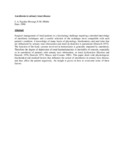| dc.contributor.author | J. A, Nguhiu-Mwangi | |
| dc.contributor.author | P.M, Mbithi | |
| dc.date.accessioned | 2013-02-24T10:52:21Z | |
| dc.date.issued | 1990 | |
| dc.identifier.citation | The Kenya Veterlnarian Vo1.l4 1990 | en |
| dc.identifier.uri | http://erepository.uonbi.ac.ke:8080/xmlui/handle/123456789/10979 | |
| dc.description.abstract | Surgical management of renal patients is a fascinating challenge requiring a detailed knowledge of anaesthetic techniques and a careful selection of the technique most
compatible with each patient's condition. A knowledge of many facets of physiology, biochemistry and med icine that are influenced by urinary tract obstruction and renal dysfunction is paramount (Deutsch 1973). The function of the basic systems involved in homeostasis is generally impaired by anaesthesia. Therefore the degree of depression
of renal haemodynarnics is inevitably of concem, especially so in anaesthesia of patients with urinary tract obstruction, or renal dysfunction (Bastron and Deutsch 1976; Deutsch 1973; Mazze and Cousins 1981). This paper deals with physiological, biochemical and medical factors that influence the action of anaesthetics in urinary tract disease,
and thus affect the patient negatively. An insight is given on how to overcome some of these factors. | en |
| dc.language.iso | en | en |
| dc.subject | Anaesthesia | en |
| dc.subject | Urinary tract disease | en |
| dc.title | Anaesthesia in urinary tract disease | en |
| dc.type | Article | en |
| local.embargo.terms | 6 months | en |
| local.publisher | Department of Clinical Studies, Faculty of Veterinary Medicine, University of Nairobi | en |

